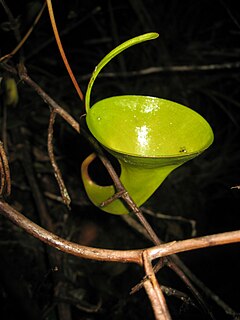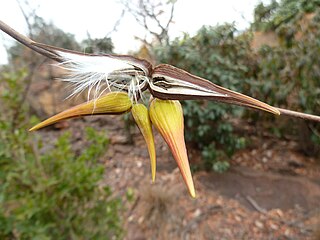
Apocynaceae is a family of flowering plants that includes trees, shrubs, herbs, stem succulents, and vines, commonly known as the dogbane family, because some taxa were used as dog poison. Members of the family are native to the European, Asian, African, Australian, and American tropics or subtropics, with some temperate members. The former family Asclepiadaceae is considered a subfamily of Apocynaceae and contains 348 genera. A list of Apocynaceae genera may be found here.

Nepenthes dubia is a tropical pitcher plant endemic to Sumatra, where it grows at an altitude of 1600–2700 m above sea level. The specific epithet dubia is the Latin word for "doubtful".

Nepenthes inermis is a tropical pitcher plant endemic to Sumatra. The specific epithet inermis is Latin for "unarmed" and refers to the upper pitchers of this species, which are unique in that they completely lack a peristome.

Nepenthes izumiae is a tropical pitcher plant endemic to Sumatra, where it grows in montane forest at 1700–1900 m above sea level. It appears to be most closely related to N. lingulata and N. singalana.

Pergularia is a genus of the botanical family Apocynaceae. Pergularia daemia is a perennial twinning herb that grows along the roadsides of India and tropical and subtropical regions in South Asia, Africa, and Australia.

Nepenthes jamban is a tropical pitcher plant endemic to northern Sumatra. The specific epithet jamban is the Indonesian word for "toilet" and refers to the shape of the pitchers.

Grevillea speciosa, also known as red spider flower, is a shrub which is endemic to New South Wales in Australia.

Levenhookia dubia, the hairy stylewort, is a dicotyledonous plant that belongs to the genus Levenhookia. It is an ephemeral annual that grows from 2–6 centimetres (0.79–2.36 in) tall with obovate leaves that are generally 2–5 millimetres (0.079–0.197 in) long. Flowers are white and bloom from September to October in its native range. L. dubia is most closely related to L. sonderi, which has been described as a variety of L. dubia in the past. It is endemic to Australia and has native ranges in Western Australia, South Australia, New South Wales, and Victoria. Its habitat has been reported as being sandy soils in granite outcrops.

Ventenata is a genus of plants in the grass family, native to Europe, North Africa, and central + southwest Asia. One species, Ventenata dubia, is considered an invasive weed in many places.
Cryptolepis may refer to:

Cryptolepis is a plant genus in the family Apocynaceae. It includes some 42 species.
Cryptolepis sinensis is a plant species in the genus Cryptolepis, native to Taiwan, China and southeast Asia.

Calochlaena dubia, commonly known as soft bracken, false bracken, common ground fern or rainbow fern, is a small Australian fern in the treefern family Dicksoniaceae. It is very common within its range, and often seen growing under eucalyptus forest, often on the poorer quality soils. It is an easy plant to grow in the garden.
Cryptolepis sanguinolenta is a species of flowering plant in the family Apocynaceae. An extract from the root is traditionally used in West Africa for malaria.

Cryptolepis cryptolepioides is a species of flowering plant in the family Apocynaceae. It is a twining climber in shrubs and trees, and is native to rocky hillsides and escarpments in northern South Africa and Zimbabwe.

Cryptolepis oblongifolia, the red-stemmed milk rope, is a multi-stemmed shrub in the family Apocynaceae. It is native to moist and mesic regions of southern Africa, where it occurs in rocky grassland, grassy woodland or riverine vegetation. It is found from South Africa to Zambia. It grows about 1m tall, and carries widely spaced, opposite leaves on the reddish-brown stems. The yellow to reddish-yellow flowers appear in axillary clusters.

Periplocoideae is a subfamily of the dogbane plant family, Apocynaceae. It was not divided into tribes as of 2014.
Pentopetia is a plant genus in the family Apocynaceae, first described as a genus in 1844.

Carex cryptolepis, known as northeastern sedge, is a North American species of sedge first described by Kenneth Mackenzie in 1914.

Kadenia dubia is a species of flowering plant belonging to the family Apiaceae.
















